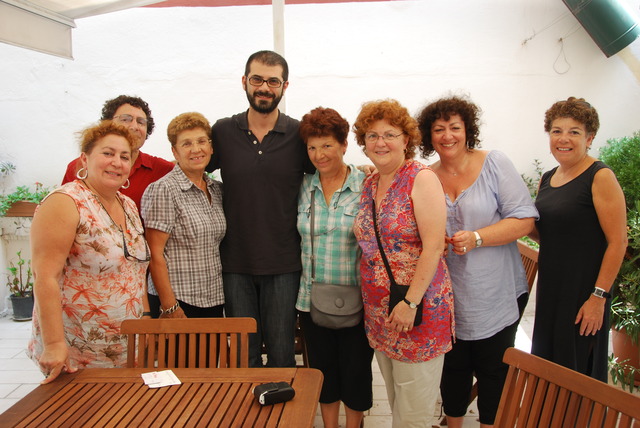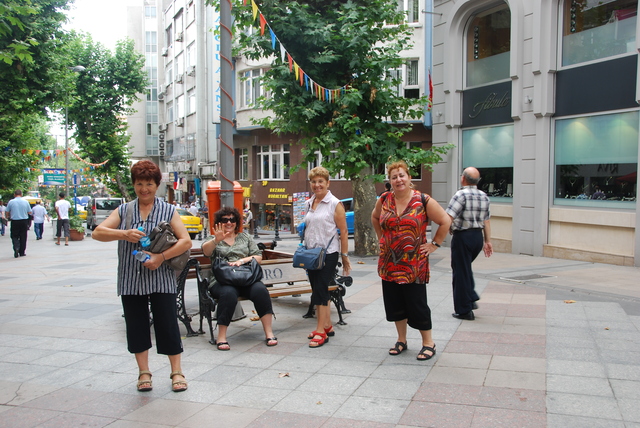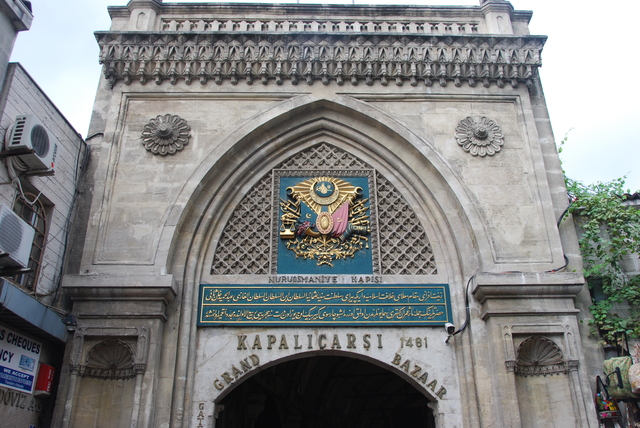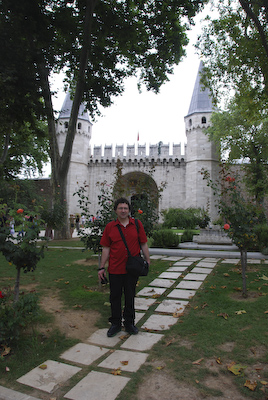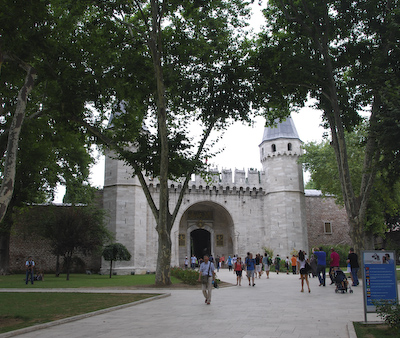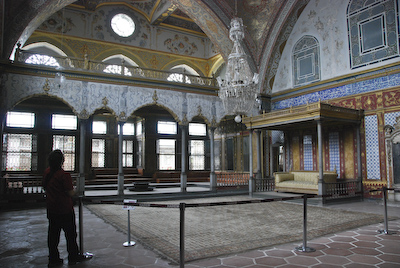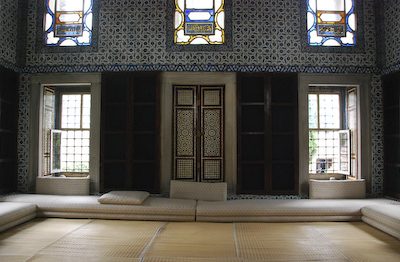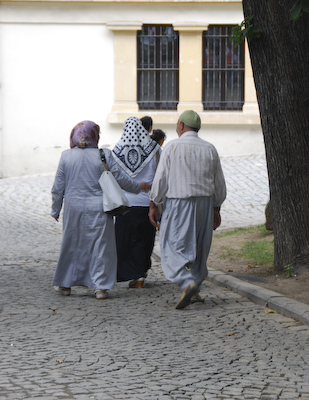What a difference a day makes! Yesterday was overcast, warm and humid. Today it’s a bright and sunny cloudless day, but still hot! Chris and I decided to finally “go over to the other side” of the Golden Horn. We had really been enjoying the historic Sultanahmet District with the museums, palaces, mosques, and other tourist attractions. Neither one of us enjoys shopping and the Beyoglu District is known for its shops.
 View From the Trim Across the Galata Bridge
View From the Trim Across the Galata Bridge
Chris and I walked up to Divan Yolu Caddesi, the main street where the tram runs. We bought our plastic tokens from the man in the bake shop window and waited for the tram. It is fast and efficient, clean and air conditioned. We took the tram from Sultanahmet to the last stop, Kabatas, and followed the signs to the funicular to Taksim Square.
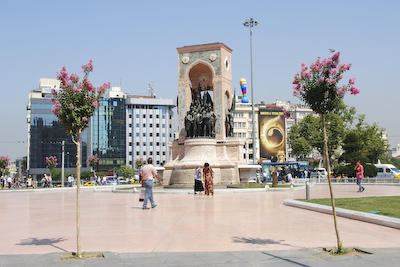 Taksim Square
Taksim Square
Ascending the stairs to arrive at Taksim Square was a shock of brilliant sunlight and crowded humanity. People and cars are scurrying everywhere and in all directions. We stood on the circle and watched the action for a few minutes to get our bearing and then followed the crowd to Istiklal Caddesi, the famous Independence Street.
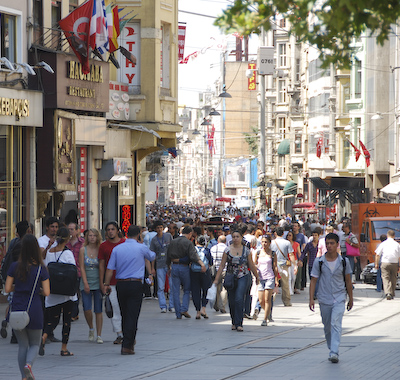 Istiklal Caddesi on a Summer Day
Istiklal Caddesi on a Summer Day
This is the youthful side of Istanbul with lots of shopping and fewer women wearing scarves. There is a Burger King, Pizza Hut, and Gloria Jean’s Coffee as well as Internet Cafes, restaurants, hotels, and shops. Fortunately, it is a pedestrian-only street, without cars. There is a small trolly car that runs on tracks in the middle of the street.
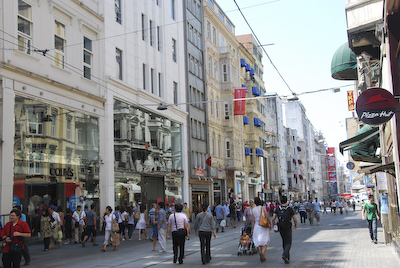 Farther Along Istaklal Street
Farther Along Istaklal Street
The guide book said that “When the Orient Express rolled into Old Istanbul in the late 1800s, promenading down Istaklal Caddesi was all the rage.” I think it still is!
 A Street Vendor on Istaklal Caddesi
A Street Vendor on Istaklal Caddesi
We continued to walk down the length of “Independence Street” looking at all the shops and vendors. There were many restaurants, clothing stores, bakeries, and music shops. Watching the people and the variety of Muslim cover-ups of the women was also interesting.

Every side street had restaurants and shops which begged to be explored. We were looking for an Armenian church which was supposed to be near the lower end of the street. We walked down an interesting side-street and found a restaurant which was supposed to have Armenian food. We asked a man who was sitting in the empty restaurant if he was Armenian. No response. He eventually called over to another waiter across the narrow street who spoke English. That man escorted us around the corner to Balik Pazari and the unassuming doors of the church.
 Interior Doors of the Armenian Church
Interior Doors of the Armenian Church
The simple double doors were between two fruit & vegetable stands. A man sitting on a stool by the door welcomed us into the inner courtyard where the Armenian Church had been built. He informed us that the church owned all the buildings around the church and collected rent from all the businesses which financed the church. It was bright and sunny in the courtyard and he led us to the door of the sanctuary.
 Interior of the Armenian Church Looking Back From the Altar
Interior of the Armenian Church Looking Back From the Altar
The scent of incense in an Armenian church is unmistakable! When we entered the sanctuary, the incense embraced me with its familiar scent. The Armenian church in St. Petersburg, Russia smelled the same as this one and the church from my childhood. The kindly man gave us a tour of the church and the courtyard and explained that they have services there every Sunday. He invited us to a wedding which was going to take place there on Saturday afternoon. Then he introduced us to two older gentlemen who were deacons of the church. We said our good byes and promised we would return with our cousins at a later time.
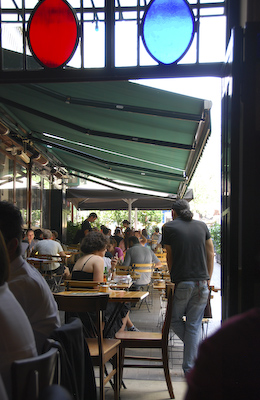 Looking Out From Ara Cafe
Looking Out From Ara Cafe
We hadn’t had lunch yet and we had another destination in mind. Chris had read about Ara Guler and he sent me information about Ara before we left home. He was the famous Armenian photographer who was born in Istanbul and still lived and worked there. He owned a cafe, aptly named Ara Cafe, and hung out there in the afternoons. The cafe is just off Istiklal Caddesi and overlooks the busy pedestrian street. It is a friendly and inviting place with a very interesting menu. Ara Guler’s black & white photographs are place-mats and adorn the walls of the restaurant.
 Black & White View of the Galata Bridge
Black & White View of the Galata Bridge
We ate a delicious lunch, but missed Ara. The waiter said he is usually present from 11:00 AM to about 1:00 in the afternoon. Well fortified and satisfied after a tasty lunch, we continued to explore the wonders of Istiklal Caddesi.
 Sant’Antonio Kilisesi – St. Anthony Church
Sant’Antonio Kilisesi – St. Anthony Church
We passed the gated courtyard of St. Antonio’s Catholic Church which a plaque said was finished in 1912. The interior was lovely, impressive Neo-Gothic architecture. We continued down the street, taking in all the sounds, smells, and sights of this busy street. We noticed several impressive foreign consulate buildings behind large protective gates.
 The French Consulate with Police Protection
The French Consulate with Police Protection
Then Chris noticed a contemporary art gallery and suggested we see their collection. On the first floor there was a giant soft blow-up military armored vehicle which inflated and deflated every few minutes. The gallery was five stories high and had a wonderful circular staircase near the elevator which begged to be photographed from many angles.
 Circular Staircase Looking Up
Circular Staircase Looking Up
We took the elevator to the top floor and enjoyed the air conditioned building. From a fifth floor window, you could see over the red-tiled roofs of Beyoglu to the Bosphorus. There were many interesting works of art in the gallery and the interior of the building was also photogenic.
 View from the Top of the Stairs
View from the Top of the Stairs
Everywhere we looked, there was a photograph! We enjoyed the gallery but we finally decided to leave and went back out into the heat of Istanbul. Independence Street was still alive with humanity and there was so much to see and experience.
 The Tram on Istiklal Caddesi
The Tram on Istiklal Caddesi
It is easier to walk the street down hill from Taksim Square to the end near Galata Tower, especially in the summer. We walked to the other funicular for the ride down to the tram stop near the Galata Bridge.
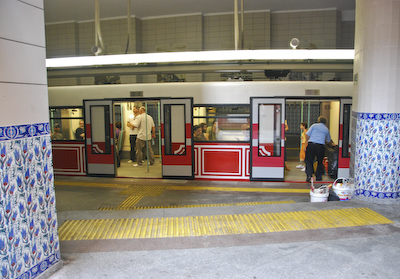 Funicular at the Station
Funicular at the Station
The Funicular just goes up and down the high hill. It seems very new and is clean and air conditioned. The station is adorned with reproductions of the gorgeous Iznik tiles. We rode the funicular down to the Beyoglu side of the Galata Bridge and followed the tunnel out to the tram station. The tunnel is full of shops selling every conceivable item of hardware and garden supplies including lawn mowers, cell phones and accessories, and wrist watches.
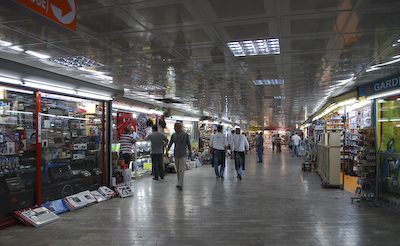 Hardware & Garden Supplies in the Tunnel
Hardware & Garden Supplies in the Tunnel
We followed the signs to the tram. The tunnel was very clean with a reflecting ceiling. I have never seen so many goods for sale! The world considers Americans as consumers, but I think the Turkish have us beat!

We took the tram back to Sultanahmet and the White House Hotel to rest and relax before dinner. Istanbul is truly an amazing city. It seems as if there is a surprise around every corner. There is so much to see and do!
 Rober Koptas is an Armenian man with keen intelligence and much patience. He laughs easily, seems to genuinely like people, and appreciates the efforts that are being made on the behalf of all Armenians.
Rober Koptas is an Armenian man with keen intelligence and much patience. He laughs easily, seems to genuinely like people, and appreciates the efforts that are being made on the behalf of all Armenians.


